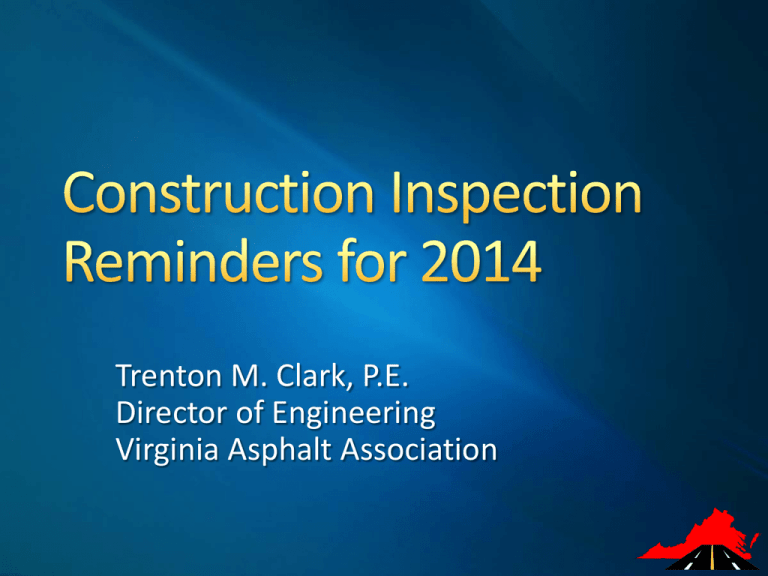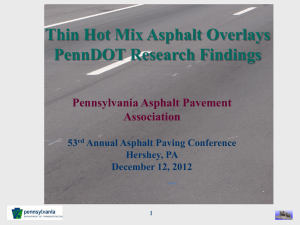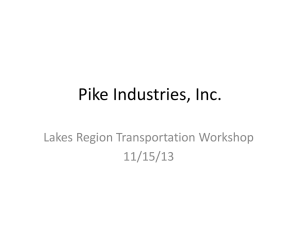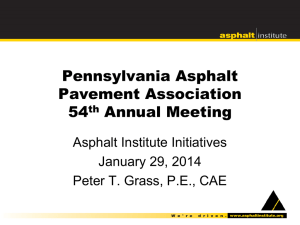Pres. 9a - Paving Inspection Reminders - Trenton Clark
advertisement

Trenton M. Clark, P.E. Director of Engineering Virginia Asphalt Association Representatives of VDOT (consultant or inspector) must be familiar with the VDOT Road and Bridge Specifications as well as Special Provisions that are found in the contract. VDOT field representatives and contractor play a vital role in the execution of the Quality Assurance Program (QAP). The QAP focuses on the processes, procedures and individuals responsible for accepting asphalt concrete (AC) in the field. This chapter will cover the key aspects of inspection and QAP. 2 Standard Drawings Standard Specifications Supplemental Specifications General notes and other written information not in a SP or SPCN in No Plan and Minimum Plan Concept contracts carry the same weight as plans Plans Special Provisions 3 Special Provisions Copied Notes Prior to Density Acceptance Site preparation Milling Tacking Equipment Placement Compaction Density Acceptance General requirements Small quantity applications VTM-76 QC test sections Independent assurance Verification testing and sampling Referee procedure 4 Two main areas of concern Repairing failed areas Clean surface 6 Failed areas not patched lead to failed overlays Two approaches to correct failures: Specify patching type, material and locations in contract Use Special Provision (SP) for Surface Preparation and Restoration Prior to Plant Mix Overlay (Volume 2) 7 Dirty surfaces lead to delamination and failures 9 Why mill a road? Remove material distress Maintain surface elevation Improve cross-section What things must be inspected? Presence of scabbing Positive drainage Cleanliness Performance milling Time frames Run-on conditions 10 How to address scabbing? New milling teeth, slowing the machine, changing the mill depth Spec Requirement? SS for Section 515 – Planing or Milling Pavement (Volume 2) Section 515.05 – Measurement and Payment How to address drainage? Cut slots, mill and fill, planning Spec requirement? Section 315.05(c) 12 How is a milled surface cleaned? Sweeping and vacuum truck Traffic SP for Placement of Asphalt Concrete Overlays under Procedures 13 What is performance milling? Milling that results in a mean texture depth of 2.0 mm or less Done with special milling heads Performed to improve ride, leave high-speed routes open to traffic, minimize scabbing Is it required in contracts? No, at the contractor’s option unless specified Described in SS for Cold Planing (Milling) Asphalt Concrete Operations (Volume 2) 14 Other Milling Inspection Items Applicable timeframes for traveling on milled surfaces set in SS for Cold Planing (Milling) Asphalt Concrete Operations Run-on situations are to be squared up for Roadways with Posted Speed Limit of 55 mph or Greater 15 What two categories of tack coat materials are approved by VDOT? Conventional Tack – Section 310 Non-Tracking Tack Coat –Volume 2 What is the specified application rate for conventional tack on mainline? Where is it found? 0.05 – 0.10 gal/sy for undiluted Section 310.03 What is the specified application rate for non-tracking tack coat on mainline? Rate recommended by the manufacturer 16 Which meets specifications? 19 20 Proper application to result in joint density Width of application for first paving pass? 2 feet – 18 to 20 inches under first pass, 4 to 6 inches protruding beyond first pass For second pass, vertical face of first pass and approximately 1 foot into lane to be paved Is This Good Joint Tacking? 21 Proper application to result in joint density Where is it specified? 315.05 (f) 22 Haul equipment – Supplemental Specification for Section 315 Section 315.03(a) Volume 2 Clean metal bodies or inert material Approved release agent (i.e. no diesel) Use of tarp – solid without tears to cover entire load Asphalt pavers – Section 315.03(b) Roller – Section 315.03(c) 23 Material Transfer Vehicle – Supplemental Spec for Section 315 Section 315.03(e) Required for SMA and other specialty mixes Minimum 15 ton combined capacity between device and paver Ability to remix in device or paver hopper 24 Aspects of placement Temperatures Base Mix Paver items 25 Plant – Max is 350F or as specified by supplier Field – Depends on designated mix and if WMA technology is used What is the minimum for non-Warm Mix Asphalt used as a base mix or intermediate mix? 40F – per Special Provision for Section 315.04(b)2 How about for Warm Mix Asphalt base or intermediate mix? Same requirements What about surface mixes with Warm Mix Asphalt? 40F – per Special Provision for Section 315.04(a) Use the nomograph for non-Warm Mix Asphalt when base temperature between 40F and 80F. 27 Challenge in cold weather WMA alone does not fix segregation Ways to address: Higher plant temperature – WMA and Conventional Avoid long hauls Complete coverage of the load Use of MTV with remixing Other WMA technologies than foaming Longitudinal joints must be offset 6” Continuous line for steering the paver Grade control with ski, joint shoe Section 315.05(c) 30 Primary purpose for most AC mixes is to reduce in-place air voids Improves material performance General questions about compaction: For most asphalt mixes, what is the minimum roller size? For most asphalt mixes, what is the maximum roller speed? For open graded asphalt base and porous friction courses, what is the minimum number of roller passes? 31 For the overlap of roller passes, what is the minimum overlap? Where is that found in the specs? 6” SP for Section 315.05(d) in Volume 2 32 Per VDOT Specification, does the roller operator roll toward or away from the pavement’s crown? If a cold joint exists, which direction should the roller proceed with the initial passes? Why? 33 Why is SMA and other specialty mixes different? SMA specific requirements: 3 mph max roller speed Highest frequency Lowest amplitude 35 New specifications for 2014 General density requirements Thin lift applications Small quantities Trench widening 37 The Virginia Department of Transportation (VDOT) requires that the Contractor perform density testing on the surface, intermediate and base courses of asphalt mats in order to determine if the specifications can be met by the job-mix used. 38 Nothing NEW, but remember: All paving requires a certified Asphalt Field Level 2 technician Mandatory monitoring of longitudinal joint density by Density Technician Joint testing locations same as QC locations 4” of joint for SM and IM; 6” of joint for BM Minimum density is 95% of mat target for each location; corrective action if not met 39 Establish a roller pattern and control strip Random testing locations for control strip and test section Typically, new QC lot at beginning of each production cycles 3 to 7 sublots per acceptance lot Average for all sublots must be 98% - 102% Two failing consecutive sublots require corrective action Final payment based on Table III-4 Application rates of 125 lbs/sy or less: Roller pattern and control strip only Cores not required 100% requires 98% - 102% of target density Payment based on Table III-4 SM-4.75A @ 90 lbs/sy Small quantity applications – locations where a roller pattern and control strip cannot be established Typical length is 1,000 feet or less Cores only for acceptance Frequency is every 100 tons Minimum density is 91.5% of Gmm Density testing requirements for patches 1 plug/core for first 20 tons 1 plug/core for every 500 tons thereafter 43 Density testing requirements for trench widening: 1 plug/core for first 500 linear feet 1 plug/core for every 2,500 linear feet thereafter Type 1 Widening – no minimum density requirement, but minimum 5 passes with 8 ton roller Type 2 and Type 3 Widening – minimum 91.5% 44







